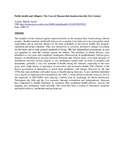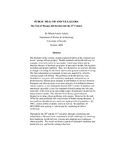| dc.description.abstract | The founders of the colonial regime expressed horror at the situation they
found among African peoples. Health standards and health delivery for
example, were believed to be surrounded veiled superstition and an
absolute absence of the basic principles of preventive health, like hygiene,
sanitation and proper nutrition. They saw themselves as saviours, destined
to change everything for the better and to raise general standards of living.
The first independent government, in turn was appalled by what the
colonial regime left behind. The problems in health delivery were
identified as very poor and completely inadequate infrastructure in
predominantly African gross inequity in distribution of services between
European and African areas, even more inequity of distribution between
various regions, a very inadequate trained staff, in terms of numbers and
attainment, generally a very low standard of health among the Africans,
especially in the rural areas, and a high degree of ignorance on preventive
and promotive health. The officials of the Kenya government at
themselves to attack these problems, with energy. However by the mid
1970s the same problems still sailed issues of health among Kenyans. A
new problem identified was a much too rapid growth of population. By
1983, a series global economic crises as well as the pandemic of
HIV/AIDS were playing a baleful part by rendering all efforts
ineffectual.
Throughout the 20th and the 21st centuries, through colonialism and
independence, Kenyans have responded to health challenges by retaining,
their traditional health delivery systems and adapting new techniques
where possible. The result has been a system of alternative medicine and
health delivery, and health seeking behaviour. | en |


